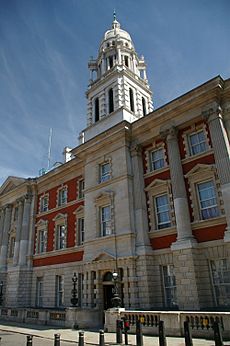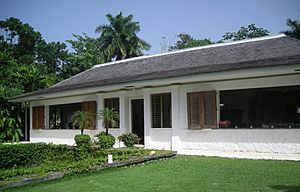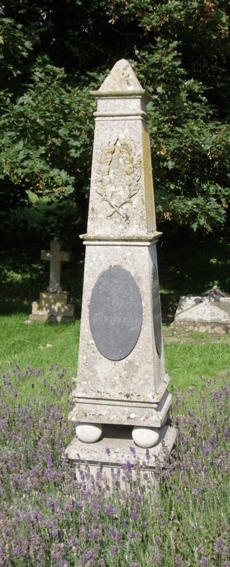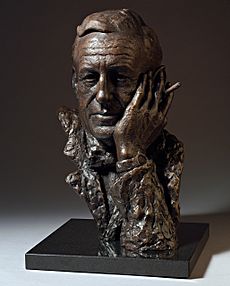Ian Fleming facts for kids
Quick facts for kids
Ian Fleming
|
|
|---|---|
 |
|
| Born | 28 May 1908 Mayfair, London, England
|
| Died | 12 August 1964 (aged 56) Canterbury, Kent, England
|
| Education | Eton College |
|
Notable work
|
|
| Spouse(s) | |
| Children | 2 |
| Parents |
|
| Relatives | Peter Fleming (brother) |
Ian Lancaster Fleming (born May 28, 1908 – died August 12, 1964) was a British writer. He is most famous for creating the James Bond series of spy novels. Fleming also wrote the popular children's story Chitty-Chitty-Bang-Bang.
Fleming came from a wealthy family in London. His father was a Member of Parliament who sadly died in World War I. Ian went to famous schools like Eton College. Before becoming a writer, he worked in different jobs.
During World War II, Fleming worked for Britain's Naval Intelligence Division. He helped plan secret missions and oversaw special intelligence units. His experiences during the war and as a journalist later inspired many details in his James Bond novels.
He wrote his first Bond novel, Casino Royale, in 1952. It was a huge success! Over the years, he wrote eleven Bond novels and two collections of short stories. The main character, James Bond, is a secret agent known as 007. The Bond books have sold over 100 million copies worldwide, making them one of the best-selling book series ever.
Ian Fleming's Life Story
Early Years and Family

Ian Lancaster Fleming was born on May 28, 1908, in Mayfair, a wealthy part of London. His mother was Evelyn Fleming, and his father was Valentine Fleming. Valentine was a Member of Parliament for Henley.
In 1914, when World War I began, his father, Valentine, joined the army. He was killed in action in 1917. Winston Churchill even wrote an obituary for him in The Times newspaper.
Ian had an older brother, Peter, who became a travel writer. Peter also served in World War II. Ian also had two younger brothers, Michael and Richard. Michael died from war wounds in 1940.
School Days and First Jobs
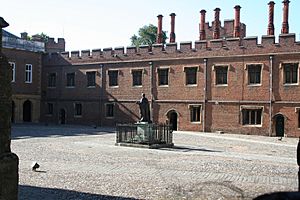
In 1914, Ian went to Durnford School, a boarding school. He didn't enjoy it much, finding the food bad and facing bullying.
In 1921, he started at Eton College, a very famous school. He wasn't the best student, but he was great at sports. He even won the "Winner of the Games" title for two years. He also helped edit a school magazine.
After Eton, he briefly studied at universities in Munich and Geneva. In 1931, he tried to join the Foreign Office but didn't get the job.
Later that year, he became a journalist for Reuters News Agency. He even reported from Moscow in 1933. After journalism, he tried working in banking and as a stockbroker, but he wasn't very successful in those roles.
World War II Service
In May 1939, just before World War II started, Ian Fleming was recruited by John Henry Godfrey, the Director of Naval Intelligence for the Royal Navy. Fleming became Godfrey's personal assistant. He joined full-time in August 1939 and was given the codename "17F."
Fleming was very good at his job, especially in administration. He often helped Godfrey communicate with other government departments, like the Secret Intelligence Service (MI6).
In 1940, Fleming wrote a famous memo called the Trout Memo. It compared deceiving an enemy in wartime to fly fishing. This memo suggested ways to trick German U-boats and ships.
He also came up with a plan called Operation Ruthless in 1940. The idea was to capture a German bomber, crash it into the English Channel, and then capture German rescuers to get their secret Enigma machine. This mission was never carried out.
In 1941, Fleming visited the United States and helped create a plan for what would become the CIA. He also led Operation Goldeneye, a plan to keep an intelligence network in Spain if Germany invaded.
30 Assault Unit
In 1942, Fleming helped create a special unit of commandos called 30 Assault Unit (30AU). These were specialist intelligence troops. Their job was to go to the front lines and capture enemy documents from headquarters.
Fleming didn't fight with the unit himself, but he chose their targets and directed their missions from behind the lines. The unit grew in size and was trained in unarmed combat and safe-cracking.
30AU had many successes in places like Sicily and Italy. Fleming visited the unit in the field during and after the Normandy landings in 1944. He also followed them into Germany, where they found German naval archives in Tambach Castle.
T-Force
The success of 30AU led to the creation of "Target Force," or T-Force, in 1944. This unit's main job was to secure important documents, people, and equipment after towns and ports were captured.
Fleming was on the committee that chose targets for T-Force. The unit found important things like German engine research centers for V-2 rockets and high-speed U-boats. Fleming later used ideas from T-Force's activities in his 1955 Bond novel, Moonraker.
In 1942, Fleming visited Jamaica and loved it so much that he decided to live there after the war. In 1945, he built a house there and named it Goldeneye. This is where he would write all his famous Bond novels.
Fleming left the military in May 1945. He received an award from Denmark for helping Danish officers escape to Britain during the war.
After the War
After the war, Fleming became the foreign manager for the Kemsley newspaper group, which owned The Sunday Times. This job allowed him to take three months of holiday every winter, which he spent in Jamaica.
Fleming married Ann Charteris in 1952, and their son, Caspar, was born later that year.
Writing James Bond
Fleming started writing his first Bond novel, Casino Royale, at Goldeneye on February 17, 1952. He said he wrote it to distract himself before his wedding. He used his own experiences and imagination to create the story.
The book was published in April 1953 and was an instant hit. Fleming designed the cover himself.

Fleming named his main character, James Bond, after an American ornithologist (a bird expert) named James Bond. Fleming loved birdwatching and had a copy of the ornithologist's book, Birds of the West Indies. He thought it was a "dullest name" which was perfect for a "blunt instrument" of a spy.
Fleming based James Bond on real secret agents and commandos he met during the war. He also gave Bond some of his own habits, like his love for scrambled eggs and gambling.
After Casino Royale, Fleming wrote a new Bond story every year during his holidays in Jamaica. Twelve Bond novels and two short story collections were published between 1953 and 1966. The last two were published after his death.
Many of the villains and characters in the Bond books were named after people Fleming knew. For example, Goldfinger was named after an architect whose work Fleming disliked.
In 1957, Fleming published his first non-fiction book, The Diamond Smugglers. It was based on his research for his Bond novel Diamonds Are Forever.
In 1961, sales of Fleming's books soared. This was partly because US President John F. Kennedy listed From Russia, with Love as one of his favorite books. Fleming considered From Russia, with Love to be his best novel.
In 1961, Fleming had a heart attack. While recovering, a friend suggested he write down the bedtime stories he told his son, Caspar. This led to his only children's novel, Chitty-Chitty-Bang-Bang, published in 1964.
The first James Bond film, Dr. No, was released in 1962, starring Sean Connery. The success of the films even influenced how Fleming wrote Bond in later books, giving him more humor.
Final Years and Death
Ian Fleming suffered from heart disease. On August 11, 1964, he collapsed with another heart attack. He died the next morning, August 12, 1964, at the age of 56. It was his son Caspar's 12th birthday.
Fleming was buried in the churchyard of Sevenhampton, England. His last two books, The Man with the Golden Gun and Octopussy and The Living Daylights, were published after he passed away.
In 1975, his son Caspar died and was buried with his father. Fleming's wife, Ann, died in 1981 and was also buried with them.
Fleming's Writing Style
Fleming's books are known for their exciting plots and detailed descriptions. He aimed to write thrillers that could also be read as literature. He was influenced by other famous mystery writers like Raymond Chandler.
Fleming had a special way of writing. He would write for about three hours in the morning and another hour in the evening. He tried not to go back and correct anything, aiming for about 2,000 words a day.
He often used "hooks" at the end of chapters to build suspense and make readers want to keep reading. He also used real brand names and everyday details to make Bond's world feel more realistic. This is sometimes called "the Fleming effect."
Key Themes in His Books
Britain's Place in the World
Fleming wrote his Bond books after World War II, when Britain was changing. The British Empire was becoming smaller. The books sometimes show this decline, with Bond admitting that Britain isn't as powerful as it once was.
Impact of War
The effects of World War II are a strong theme in the Bond series. Fleming often used characters' wartime experiences to show if they were good or evil. For example, some villains were former Gestapo officers.
Friendship and Loyalty
Friendship is also important in the Bond books. Bond often works with male allies, like Felix Leiter, who help him on his missions. Bond shows strong loyalty to his friends, especially when they are in danger.
Good vs. Evil
The most obvious theme in the series is the fight between good and evil. This is clearly shown in Goldfinger, where Bond is like Saint George fighting a dragon.
Anglo-American Relations
The Bond novels also explore the relationship between Britain and America. While America played a big role in defending the West, Fleming's books sometimes showed a subtle tension. Bond, the British agent, often takes the lead, even when dealing with American problems.
Fleming's Legacy
Ian Fleming's books were very popular during his lifetime, selling 30 million copies. That number doubled in the two years after his death. In 2008, The Times newspaper named him one of the "50 greatest British writers since 1945."
After Fleming's death, other authors were asked to continue writing James Bond novels. The first was Colonel Sun in 1968.
The Eon Productions series of Bond films, which started with Dr. No in 1962, has continued for many years. There have been twenty-five Eon Bond films, making it one of the highest-grossing film series ever.
Fleming's creation, James Bond, has also influenced many other films and books, like the Austin Powers movies. In 2011, an airport in Jamaica was named the Ian Fleming International Airport in his honor.
In 2023, it was announced that Ian Fleming's James Bond books would be republished with some language updated to be more sensitive for modern readers. A note was added to the beginning of each book explaining this.
Ian Fleming's Works
|
|
Films About Ian Fleming
- Goldeneye: The Secret Life of Ian Fleming (1989): A TV film starring Charles Dance as Fleming. It focuses on his life during World War II and how he created James Bond.
- Spymaker: The Secret Life of Ian Fleming (1990): Another TV film with Jason Connery (Sean Connery's son) playing Fleming in a spy adventure.
- Ian Fleming: Bondmaker (2005): A TV documentary-drama from the BBC.
- Ian Fleming: Where Bond Began (2008): A BBC documentary presented by Joanna Lumley.
- Age of Heroes (2011): A film based on the real-life actions of 30 Commando, with James D'Arcy as Fleming.
- Fleming: The Man Who Would Be Bond (2014): A four-episode TV mini-series starring Dominic Cooper as Ian Fleming.
See also
 In Spanish: Ian Fleming para niños
In Spanish: Ian Fleming para niños
- Outline of James Bond


